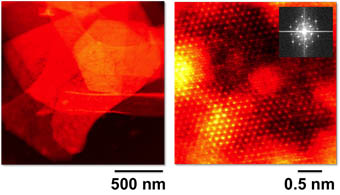
Research conducted at the Institute of Molecular Science (ICMol) of the University of Valencia has made it possible to generate multifunctional materials with different capacities such as responding to thermal stimuli, changing colour, being magnetic and presenting movement at the microscale as a result of a variation in their molecular structure.
The conclusions of this study led by researcher Gonzalo Abellán and directed by professors Eugenio Coronado and Hermenegildo García have been published in the journal ‘Chemical Science’.
This study —carried out jointly by the Institute of Chemical Technology (ITQ) of the Universitat Politècnica de València within the framework of the VLC/Campus research microcluster Functional Nanomaterials and Nanodevices, and the Universidad Autónoma de Madrid— presents what researchers call breathing materials “because of the movement of the crystals, resembling an accordion opening and closing”, says Gonzalo Abellán, who is now a Marie Curie postdoctoral researcher in the group of Professor Andreas Hirsch at the University of Erlangen-Nuremberg (Germany).
Abellán explains that they have synthesised hybrid materials “based on layered double hydroxides intercalated with thermochromic molecules, that is, that change colour with temperature. The system resembles a sandwich: the layers are the hydroxides, which are magnetic in our case, and the interlayers are the photoactive molecules incorporated”.
The importance of this finding is that researchers have been able to rationalise the influence of the way in which molecules are connected to the layers. “If anchoring occurs only through one end of the molecule, the layers have a completely reversible sliding movement —which we call breathing— when applied an external stimulus, in this case, a small change in temperature, whereas if the sheets are connected through both ends, the movement generates compression and a lot of tension and movement is more limited. This is reflected dramatically in the optical and magnetic properties of these materials”, explains Gonzalo Abellán.
This study evolved from previous work carried out between ICMol and ITQ, which showed that the magnetic properties of a hybrid material could be modulated with light. At the same time, however, many questions arose as regards the main factors that control the movement of these systems at will, or the role played by the chemical design of the magnetic sheets and of the organic molecules intercalated in between them.
Stimuli-responsive hybrid materials: breathing in magnetic layered double hydroxides induced by a thermoresponsive molecule. Chemical Science, DOI: 10.1039/C4SC03460K; Chem. Sci., 2015, 6, 1949-1958. Gonzalo Abellán, Jose Luis Jordá, Pedro Atienzar, María Varela, Miriam Jaafar, Julio Gómez-Herrero, Félix Zamora, Antonio Ribera, Hermenegildo García and Eugenio Coronado
Last update: 7 de april de 2015 07:00.
News release



















